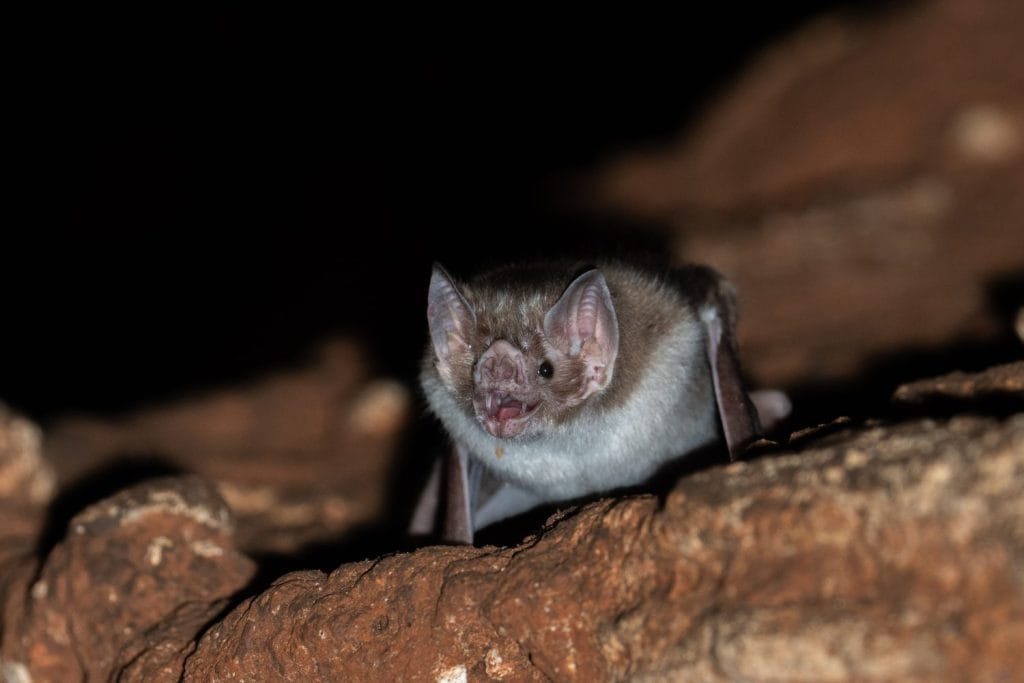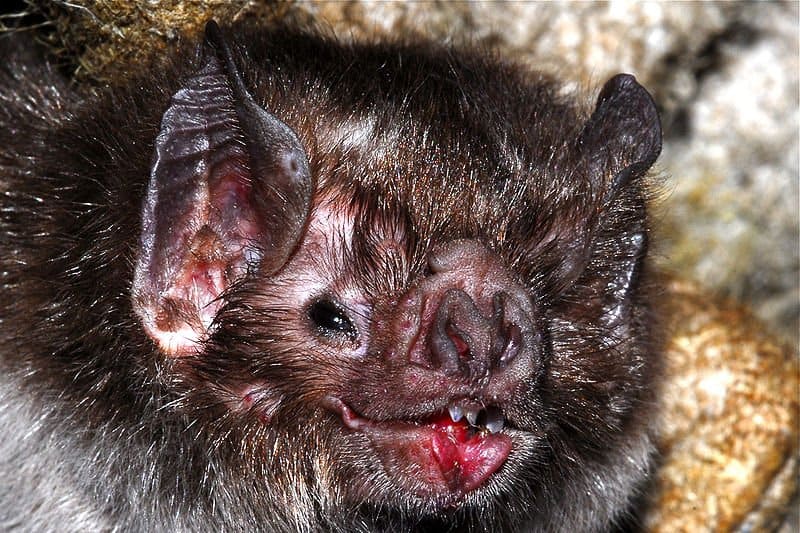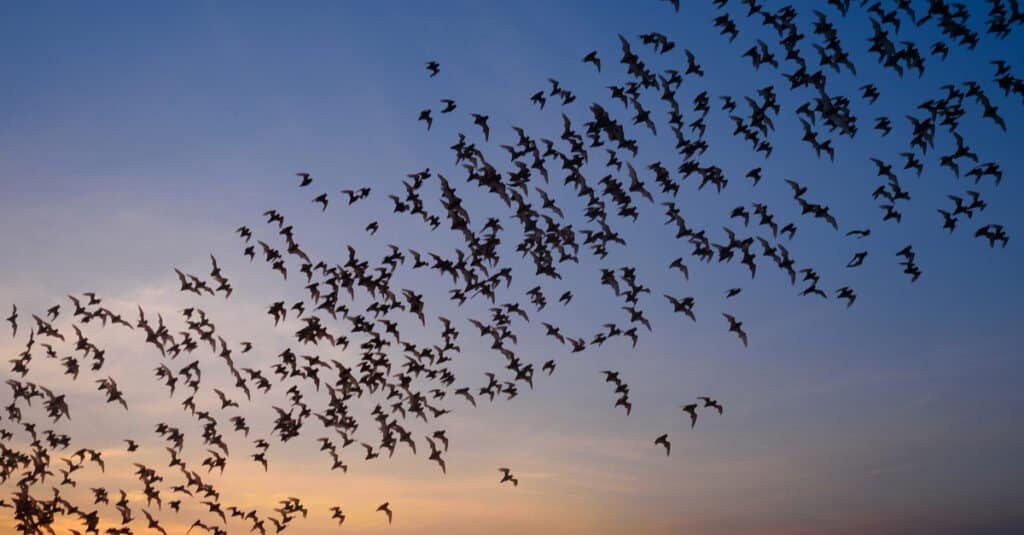
The post Why Vampire Bats Regurgitate Blood for Their Hungry Friends appeared first on A-Z Animals.
Humans are often happy to share food with their friends, but what about animals? Contrary to their reputation, vampire bats are surprisingly social and generous, and a well-fed bat will even regurgitate blood to help a hungry friend.
To better understand this unusual behavior, AZ Animals turned to the experts at Merlin Tuttle’s Bat Conservation (MTBC). Founded in 2014, MTBC uses science, field experience, and photography to protect bat populations and educate the public on how to live alongside these often-misunderstood animals. Melissa Donnelly, MTBC’s science specialist, provided us with key insights into the surprising reasons behind this cooperative behavior.
The Spectacular Vampire Bat

Vampire bat colonies demonstrate cooperation, tolerance, and low levels of aggression.
©Griffin Gillespie/Shutterstock.com
There are just three types of vampire bats: the common vampire bat (Desmodus rotundus), the hairy-legged vampire bat (Diphylla ecaudata), and the white-winged vampire bat (Diaemus youngi). All three species are sanguivores, meaning their primary diet is blood, though some species may occasionally consume other foods such as fruit or nectar. But don’t worry, they are nothing like the vampires you see in movies; real vampire bats don’t haunt humans or fraternize with the undead.
The common vampire bat is the most well-known species, found in southern Mexico and throughout South America. These small bats weigh less than 2 ounces and have a wingspan of around 12 to 15 inches. Hairy-legged and white-winged vampire bats mainly consume blood from birds, such as domestic chickens, though the hairy-legged vampire bat may also occasionally feed on mammals. In contrast, the common vampire bat primarily feeds on the blood of large mammals, such as horses, cows, pigs, and tapirs.
Unlike what you might see in a horror film, vampire bats don’t “suck” blood or even kill their prey. Instead, their sharp front teeth slice a tiny cut in an animal’s skin, and the bat laps up the pooling blood. Their saliva contains a special compound that prevents the blood from clotting, allowing them to feed for as long as they need to.
Vampire bats are one of the most intelligent species I’ve worked with.
Melissa Donnelly, science specialist at Merlin Tuttle’s Bat Conservation
An All-Blood Diet

Vampire bats make a tiny cut in their prey’s skin without waking the animal.
©Sandstein / CC BY 3.0 / Wikimedia Commons – Original / License
Over 1,400 species of bats live across the globe, but only three of them feed on blood. As vampire bats evolved, they lost a number of specific genes that allowed them to adapt to a blood-based diet. For example, they lost genes related to insulin, helping them adapt to a low-sugar, high-protein blood diet. Another lost gene normally helps store energy in the liver. The loss of this gene is one of several adaptations that allow vampire bats to survive on a blood diet that contains very little sugar. Losing other specific genes has allowed vampire bats’ stomachs to digest blood better and get rid of excess iron from their meals, protecting them from potentially toxic levels.
Recent research suggests that the loss of a specific gene, CYP39A1, may be associated with the evolution of advanced cognitive abilities in vampire bats, though this connection is still under investigation. This heightened intelligence is demonstrated in their social intelligence and empathy: If a bat in their colony is unable to find food, another bat will regurgitate some of its own recently consumed meal to share.
Survival Through Sharing

Vampire bats lap up blood with their tongue like a dog or a cat.
©Scherbi/Shutterstock.com
While adapting to an all-blood diet was a successful evolutionary strategy for vampire bats, it still presents a major challenge. Melissa Donnelly, the science specialist at MTBC, told A-Z Animals, “Blood is a very nutritionally poor diet.” Although it is rich in protein and certain minerals like iron, blood consists mainly of liquid with very few calories, vitamins, or sugars. To get enough energy, bats must consume up to 50 percent of their body weight in blood every night.
However, finding a blood meal is a challenge, and occasionally, bats must go without. Donnelly explains, “Since blood meals are hard to find and missing even one can be deadly, bats that have fed will share their meal with roostmates who haven’t been successful. This is a very common behavior; it’s essential for their survival.” This is especially true for young, inexperienced bats. “Studies show 33 to 50 percent of juvenile bats fail to feed on a given night,” Donnelly says. “So the need for help is frequent. A vampire bat can die after two to three days without feeding, making sharing critical.”
Reciprocal Altruism in Vampire Bats

Grooming each other helps vampire bats strengthen bonds within their colony.
©Oasalehm / CC BY-SA 4.0 / via Wikimedia Commons – Original / License
For a long time, scientists believed that vampire bats shared food only with relatives or when forced to do so. However, a recent two-year experiment challenged this idea and revealed that vampire bats practice reciprocal altruism. This means they help others with the expectation that they’ll receive help in return later on. Interestingly, the study found that it’s usually the fed bat — the one with a full belly — that initiates the sharing, not the hungry one begging for food. This proves that donor bats actively go out of their way to find and help a roostmate in need.
What’s even more fascinating is that most bats that share food are not related. Instead, the best predictor of whether a bat will share is how much food it has received from others in the past. “The primary evolutionary purpose is reciprocal altruism, which helps explain how cooperation can evolve between non-kin in species with high social intelligence and repeated interactions,” says Donnelly. “This helps both the giver and receiver over the long term to increase their survival by building these reciprocal bonds. Further, natural selection favors cooperation when the cost of sharing is low compared to the benefit received later. This behavior helps build social bonds and increases the chances that the favor will be returned in the future, improving survival for all involved.”
This suggests that sharing is not a matter of relatedness or force, but a core part of vampire bat social structure. These social bonds are further strengthened by other behaviors as well. Bats that share food also tend to groom each other more often, highlighting that food sharing is just one part of a large, reciprocal relationship.
Trust and Cheating in Vampire Bat Society

White-winged vampire bats mainly consume blood from birds.
©Gcarter2 / CC BY-SA 2.5 / Wikimedia Commons – Original / License
The unique sharing system among vampire bats leads to an interesting question: Do well-fed bats ever refuse to share? “I do not know about ‘refusal to share,'” says Donnelly. “But evidence shows that a ‘friend’ (i.e., an individual who has previously shared) is more likely to share than receive in the future, based on social bonding.” This suggests that the bond itself is a powerful motivator.
Common vampire bats are incredibly social creatures, living in colonies that can range from a few dozen to thousands of individuals. These colonies have a sophisticated social structure with a complex code of conduct. Female bats, in particular, form strong bonds with other females, often being the most active participants in both social grooming and food sharing. This further highlights how these unique behaviors are not isolated acts, but rather part of a deeply interconnected social life.
The Freeloader Problem

Vampire bats have specialized heat sensors that help them detect infrared radiation from warm-blooded animals.
©Desmodus / CC BY-SA 3.0 / Wikimedia Commons – Original / License
Do bats ever take advantage of their “friends” in this social system? The answer is no, because their sharing system has built-in protections against freeloaders. According to MTBC’s science team, blood sharing in vampire bats is an altruistic behavior. This means that when an individual shares blood, there is an expectation that the favor will be returned. If the bat doesn’t return the favor, it likely won’t be getting fed again.
A 2013 study by G. Carter also revealed that bats practice selective reciprocity. This means they are more likely to withhold food from a bat that has not previously shared with them.
However, the dynamics of blood sharing among vampire bats are more than a simple give-and-take. Donnelly explains, “Researchers are finding that vampire social networks and how they ‘make friends’ is a little more complex than that.” Recent studies show that bats first build a bond through social grooming. They only begin to share food once this trust is established, which helps prevent them from being taken advantage of.
A Glimpse Into Vampire Bat Intelligence

Vampire bats are nocturnal and avoid bright light.
©belizar/Shutterstock.com
Beyond mere physical survival, blood sharing among vampire bats points to an advanced level of social intelligence. According to Donnelly, “Vampire bats are one of the most intelligent species I’ve worked with. Usually, most bats, when initially captured, will struggle and be frantic because they think they’re about to get eaten… they’re not paying attention to what you’re doing.” Vampire bats, in contrast, do not panic, but they remain highly aware. Donnelly says, “Vampire bats will follow your every movement, and when you drop your guard, or your hand gets too close, that’s when they’ll nab you.”
In addition to social intelligence, new research suggests that vampire bats possess empathy and engage in emotion-based reciprocity. After a recent visit to the Bat Lab in Gamboa, Donnelly told A-Z Animals that the team is learning that vampire bats have surprisingly human-like social networks.
Making people less afraid is one of the best ways to help bats.
Melissa Donnelly
Vampire Bat Myths Debunked

Hairy-legged vampire bats have smaller ears and fur on their legs.
©Mendesbio/Shutterstock.com
Vampire bats are likely not the first animals that come to mind when you think of “cute” or “cuddly” creatures. However, their altruistic relationships challenge many of these previous perceptions. “Helping an individual in need or feeding someone not feeling well is a very human thing,” Donnelly points out. “Instead of being seen as bloodthirsty villains, [vampire bats] become cooperative, empathetic caregivers — a trait more often admired in humans and primates.” These human-like behaviors and friendships help to make vampire bats more relatable, which Donnelly believes can positively shift the negative perceptions people have of bats. By learning about and understanding their cooperative and empathetic nature, we can see them not as frightening creatures, but as complex, social animals.
Moreover, the MTBC science team points out that blood sharing is just one example of the “human-like” behaviors observed in bat populations around the world. Many bat species, including vampire bats and flying foxes, regularly groom one another. Some bats even act as “midwives,” assisting other females during birth. Other species, like the greater spear-nosed bat, participate in communal pup-rearing. Additionally, Spix’s disk-winged bats teach each other how to find food and navigate their surroundings.
New research on vampire bats can help us better understand them and their vital role in global ecosystems. Donnelly notes that most people don’t know how essential bats are for healthy ecosystems. For instance, millions of bats are crucial for controlling insect populations, dispersing seeds, and pollinating flowers, including many of the world’s most valued plants.
Simple education can be invaluable in changing people’s perceptions and behaviors.
Melissa Donnelly
Donnelly shared a powerful example of how learning more about bats can lead to monumental change. When Norma Monfort sought to protect a bat cave in the Philippines, Merlin Tuttle educated the local community about the bats’ vital role within their ecosystem. “He showed the mayor and local citizens photos of the bats pollinating durian flowers — one of Southeast Asia’s most valuable fruits,” says Donnelly. “In no time, they had signed a successful petition to have the bats saved.”
A New Appreciation for Bats

Keeping the Earth’s ecosystems in balance requires millions of bats.
©Photoongraphy/Shutterstock.com
A vampire bat sharing a regurgitated meal with a friend may seem peculiar to us, but it is actually a profound display of altruism and social intelligence. Rather than a strange biological quirk, this behavior showcases the complex cooperative strategies that bind vampire bat colonies together. It is a core survival strategy that demonstrates a level of cooperation that challenges our traditional understanding of animal intelligence. A bat’s willingness to share a life-sustaining meal with a hungry companion, even when it comes at a personal cost, highlights a sophisticated form of reciprocity.
“When you think of a ‘bloodsucker,’ a kind, caring individual helping their friends doesn’t spring to mind,” says Donnelly. “Simple education can be invaluable in changing people’s perceptions and behaviors. As Merlin has said many times before, people seldom protect — and often despise, or even kill — animals that they fear. Making people less afraid is one of the best ways to help bats.”
Understanding these behaviors encourages us to move past fear and see bats not as pests or monsters, but as highly cooperative beings with deep connections, complex social lives, and an essential role in our ecosystems.
Melissa Donnelly, Science Specialist at Merlin Tuttle’s Bat Conservation in Austin, Texas

MTBC Science Specialist Melissa Donnelly hand feeding a Waterhouse’s leaf-nosed bat (Macrotus waterhousii) in Cuba.
©MELISSA DONNELLY Science Specialist, Merlin Tuttle’s Bat Conservation – Austin, TX
Melissa Donnelly is a Canadian-born bat biologist whose passion began in childhood and grew into a global pursuit. She has worked with bat species across four continents, from mist-netting in Panama and Indonesia to conservation outreach in Cuba and acoustic monitoring in Canada. Melissa co-founded Proyecto CUBABAT, supported international research through Operation Wallacea, and contributed to the Toronto Zoo’s Native Bat Conservation Program. In 2023, she joined Merlin Tuttle’s Bat Conservation in Austin, Texas, where she helps with fieldwork, provides photography support, organizes trips, and conducts public outreach. Known for her strong biology background and hands-on conservation work, Melissa is dedicated to connecting people to the often-misunderstood world of bats. Learn more at MerlinTuttle.org.
The post Why Vampire Bats Regurgitate Blood for Their Hungry Friends appeared first on A-Z Animals.
August 23, 2025 at 12:02AMKellianne Matthews
.jpeg)
.jpeg)

0 Comments